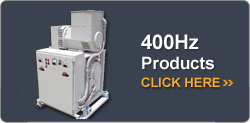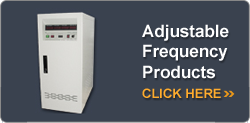Frequency Converters accomplish voltage and frequency conversion by electro-mechanical or electronic (static) means. Each method of power conversion has its own attributes, which may affect your choice of the type Frequency Converter to rent.
Motor-Generator Overview
Motor-Generators (MG Sets) use electro-mechanical means for conversion of voltage and frequency. MG sets are comprised of an ac motor operating directly from the 60 Hertz utility power line in your facility with its shaft coupled to the shaft of a synchronous generator. The generator produces the new frequency and voltage levels.
Generator Output Voltage Regulation
The generator output voltage is regulated by a solid-state voltage regulator that continuously samples the generator output terminal voltage and makes the needed control adjustment to maintain output voltage within specifications. Typical output voltage regulation is +/-1% or better during 0% to 100% steady state load conditions.
Generator output voltage can be user adjusted over a range of approximately +/-8% of nominal output voltage rating (wider range on some models), and is facilitated by a Volts Adjust control located at the operator control panel.
Generator Output Frequency Regulation
The synchronous generator output frequency is directly proportional to the RPM of the generator shaft. Depending on the type of motor that is driving the generator shaft, the output frequency may remain exact or have a regulation tolerance of up to +/- 2.5% of nominal rated output frequency during 0% to 100% load conditions.
Precise Synchronous Motor Operation
An MG Set operating from your facility 60HZ utility power having an output frequency rating of 50HZ and using a synchronous AC motor, will provide precise 50.0HZ at any output load condition from 0% to 100% rated load. This tight frequency regulation is obtainable due to the inherent ability of the synchronous motor to maintain the same RPM at any load amount up to 100% rated load.
Induction Motor Operation
Some MG Sets incorporate the use of standard AC induction motors (asynchronous motor) to drive the synchronous generator shaft. The operating characteristic of an AC induction motor allows the generator RPM to decrease as the load on the shaft increases. With an MG set operating from your facility 60HZ utility power having an output frequency rating of 50HZ, the output frequency will not be exact, and generally will range from 50.5HZ or higher to 49.5HZ or lower depending on the MG design, input voltage level, and the amount of load connected to the generator output.
Effects Of Unstable Frequency On The Load
In most applications, unstable frequency is undesirable. For example, in a test environment, using a frequency converter with unstable frequency, can cause the Unit Under Test (UUT) to miss-operate or cause erroneous test data. When merely operating 50HZ equipment from the unstable frequency, there can be an oscillating or resonating interaction between the load and the MG Set that can result in miss-operation of the equipment in the load.
Nearly all rental MG Sets in our rental fleet incorporate a true synchronous ac motor, which insures a stable frequency power source for the load. If an MG Set incorporating an AC induction motor is offered to any AP&C rental customer, our application engineer will help to insure its compatibility with the customers load.
Effects of Load Equipment on MG Set Output
The types of loads connected to the output of a frequency converter play a major role in Frequency Converter selection. Each type of load equipment or circuit exhibits characteristics that must be taken into account in order to help insure equipment proper operation or acceptable results. The following are just some of the load variants that can affect the performance of the Frequency Converter output.
Effects of Inrush Current Loads
Certain types of load equipment or circuits use substantially more current when they are first energized than when they are in operation. Loads containing motors, transformers, electronic power supplies or converters with input capacitors all have the characteristic of drawing an instantaneous peak current for the first 3-5 cycles, of 5 to 60 times or more than their rated full load current.
When an inrush current load is connected to the MG output, the voltage level of the generator will momentarily dip in proportional to the load peak current and interval. This momentary voltage can be up to 30% or more below rated output voltage. Once the inrush current time period is finished, the voltage regulator will regulate the output voltage to within the rated voltage regulation specification, typically +/-1% or less. Industry has adopted the 30% dip the maximum allowed reduction of voltage that should occur, in order to help insure the normal operation of most load equipment. A maximum allowed voltage dip of 10% is recommended for more sensitive load equipment such as certain medical or scientific devices. Our experienced application engineers will help to identify the equipment in your load which are considered inrush current loads.
Effect of Single Phase Load on MG Set Three Phase Output
The use of a single phase output frequency converter is recommended for use with single phase loads. However, at times, the load equipment or UUT is made up of single phase and three phase components.
When single phase loads are connected to the three phase output of an MG set frequency converter, they must be distributed as evenly as possible between the three phases. In addition to the possibility of generator and three phase load equipment overheating a voltage unbalance can occur.
When a single phase load is connected to the MG Set three phase output, the voltage level on the loaded phase will tend to decrease, while the voltage level on the unloaded phases will increase. As the imbalance of load current on each phase increases, the voltage levels can become exaggerated such that the MG Set output is disabled by safety circuits, or the load equipment or UUT miss-operates or fails. Exceeding approximately 2 perecent voltage unbalance can cause generator or three phase load equipment overheating and possible failure.
Effect of Non-Linear Loads on MG Set output
Non-linear loads are those loads or UUT that incorporate electronic power devices such as Diodes, SCR’s or Power Transistors. These devices are found in such equipment as Variable Speed Drives, Uninterruptible Power Supplies, AC/DC Power Supplies and Inverters.
Non-linear loads cause distortion of the sine wave output of the Frequency Converter MG Set, as well as added heating in the generator windings. If non-linear loads create excessive sine wave distortion on a given MG Set output, the output voltage can become unstable causing miss-operation of the load equipment or MG Set output to become disabled by its’ safety circuits.
Motor Generator Set Physical Characteristics
Motor-Generator Sets are considered by many to be large, heavy and rugged in comparison to their Electronic Based frequency converter counterparts. MG Sets lend themselves to operating in environments such as weather protected (not necessarily indoors), or in rooms containing other electrical equipment such as power transformers and air compressors.
Audible noise generated by MG Sets is generally dependent on KVA rating, and typically ranges from approximately 70dbA to 90dbA when measured at a distance of 3 feet from the equipment.
It is for the above primary reasons that when sizing and selecting a Motor-Generator based frequency converter for a given load, our application engineers should be consulted.
Disclaimer: All descriptive information is provided as general non-specific equipment characteristics, and is offered to give our rental customers a means to better understand Frequency Converters and their applications. The reader should contact AP&C Application Engineers for in-depth or specific technical information regarding Frequency Converters and their use.
Electronic / Static Frequency Converter Overview
Electronic or Static frequency converters make the conversion of your facility 60 Hertz utility power line using rectification changing the AC utility power line to a Direct Current voltage level, then using this DC level with semiconductor switching technology to make the new frequency and voltage levels.
Output Voltage Regulation
The Electronic frequency converter output voltage is regulated by solid-state voltage regulator(s) that continuously samples the output phase voltage and makes the needed control adjustment in order to maintain output voltage to within specifications. Typical output voltage regulation is +/-1% or less during 0% to 100% steady state load conditions.
Electronic frequency converter output voltage can be adjusted by the user over a range of approximately +/-10% of nominal (wider range on most models), and is facilitated by a Volts Adjust control(s) located at the operator control panel.
Electronic Frequency Converter Output Frequency Regulation
The output frequency of the electronic frequency converter is regulated using a precise crystal oscillator circuit. The output frequency remains constant independent of load within +/- 0.01%.
Effects of Load Equipment on Electronic Frequency Converter Output
The types of loads connected to the output of a frequency converter play a major role in Frequency Converter selection. Each type of load equipment or circuit exhibits characteristics that must be taken into account in order to help insure equipment proper operation or acceptable results. The following are just some of the load variants that can affect the performance of the Frequency Converter output.
Effects of Inrush Current Loads
Certain types of load equipment or circuits use substantially more current when they are first energized than when they are in operation. Loads containing motors, transformers, electronic power supplies or converters with input capacitors all have the characteristic of drawing an instantaneous peak current for the first 3-5 cycles, of 5 to 60 times or more than their rated full load current.
When an inrush current load is connected to the Electronic Frequency Converter output, the voltage level of the frequency converter will dip momentarily proportional to the load peak current and interval. The electronic frequency converter regulation circuits make corrections instantaneously which results in a high peak current. Once the inrush current time period is finished, the voltage regulator circuits will regulate the output voltage to within the rated voltage regulation specification, typically +/-1% or less.
The characteristic of the quick responding voltage regulating circuits enables the peak current to be much higher than that of the MG Set frequency converter. When this peak current exceeds the limited overload capacity of the electronic frequency converter, the converter responds by disabling its’ output by shutting down output to the load.
Effect of Single Phase Load on Electronic Frequency Converter Three Phase Output
The use of a single phase output frequency converter is recommended for use with single phase loads. However, sometimes the load equipment or UUT is made up of single phase and three phase components.
When single phase loads are connected to the three phase output of an Electronic Frequency Converter, they should be distributed as evenly as possible between the three phases following best electrical practices. However, unlike the Motor Generator Frequency Converter, each output phase voltage is separately regulated. Therefore, the voltage level of one output phase will not affect the regulation of other output phases.
Effect of Non-Linear Loads on Electronic Frequency Converter Output
Non-linear loads are those that incorporate electronic power devices such as Diodes, SCR’s or Power Transistors. These devices are found in such equipment as Variable Speed Drives, Uninterruptible Power Supplies, AC/DC Power Supplies and Inverters.
Non-linear loads cause distortion of the sine wave output of the Frequency Converter, as well as added heating in the output transformer windings. If non-linear loads create excessive sine wave distortion on a given Electronic Frequency Converter output, the waveform correction circuits of the frequency converter will compensate to a degree. Depending on the amount of distortion, the output voltage can become unstable causing miss-operation of the load equipment or Electronic Frequency Converter output to become disabled by its’ safety circuits.
Electronic Frequency Converter Physical Characteristics
Electronic Frequency Converters are typically used in a laboratory or relatively clean environment. They are typically smaller, lighter and quieter than their MG Set Frequency Converter counterparts. Electronic Frequency Converters can be fitted with caster wheels, and need a clean operating environment such as a laboratory or factory test department.
Audible noise generated by Electronic Frequency Converters is generally dependent on its’ KVA rating, and typically ranges from approximately 65dbA to75dbA when measured at a distance of 3 feet away.
It is for the above primary reasons that when sizing and selecting an electronic frequency converter for a given load, our application engineers should be consulted.
Disclaimer: All descriptive information is provided as general non-specific equipment characteristics, and is offered to give our rental customers a means to better understand Frequency Converters and their applications. The reader should contact AP&C Application Engineers for in-depth or specific technical information regarding Frequency Converters and their use.





